The art of the Garden in Boulogne
Living in Boulogne-sur-Seine since 1892, Albert Kahn spent 30 years acquiring parcels of land near his villa. He thus compiled a 4.2-hectare property, where several types of gardens lie alongside one another according to the principle of the scenic landscape park theorized by the landscapist Edouard André.
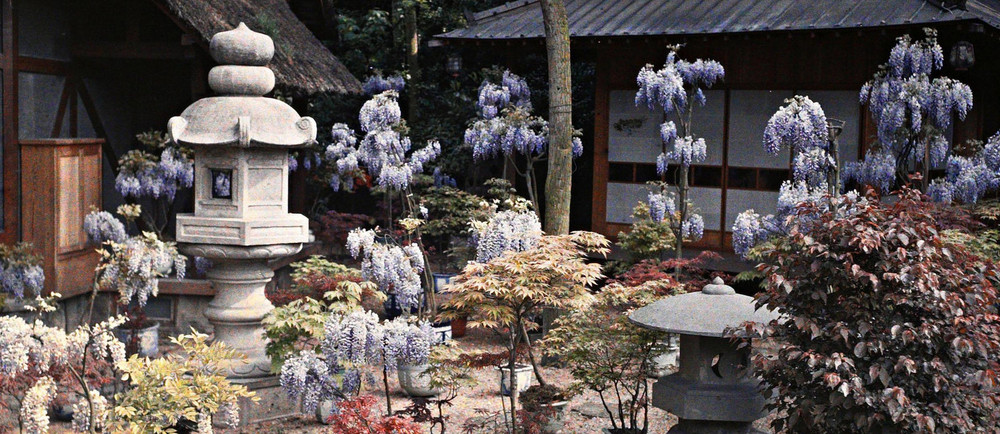
The site’s organization was initiated by Achille Duchêne, a high-society landscaper, who had created a new genre, the mixed garden (combination of classical regularity and an English garden). Alongside his head gardener, Kahn was strongly involved in the creation and upkeep of his park. Two scenes had personal resonance: la forêt vosgienne (the Vosges Forest), an homage to the nature of his youth, and levillagejaponais (the Japanese Village), an ode to one of his favorite countries.
The garden was part of a landscaping trend found in several of the neighboring properties. Edmond de Rothschild created a Japanese garden in the park of his château in Boulogne. The President of the Regional Horticultural Society – to which Kahn belonged – had an orchard-rose garden, a marsh, a winter garden and a forest of conifers. Right next to the banker, between the route de la Reine and the rue de Sèvres, was the Hersent garden, with English and Japanese sections as well as a woodland scene of foxtails.
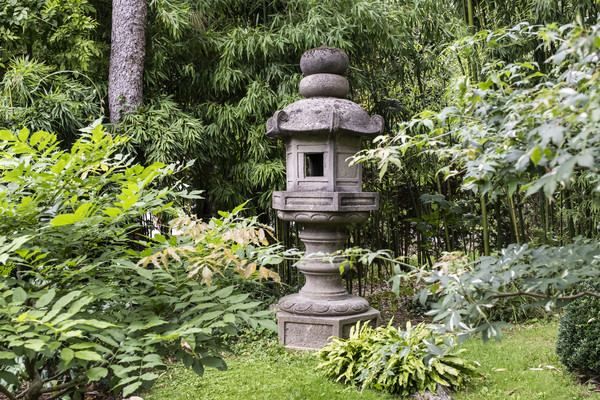
The garden is peppered with buildings – the greenhouse in the jardin français and its winter garden, the Japanese pavilions, bridges, etc. – and decorations – Japanese lanterns in stone and metal, contemporary sculptures – which today are an integral part of The Musée Départemental Albert-Kahn’s collections.
The garden was a place to socialize, share ideas as well as influence others and it was here where Albert Kahn invited personalities from his network in order to raise awareness about his humanist ideas. Albert Kahn received his guests here, organized screenings of the images from his documentary project The Archives de la Planète by his camera operators and, more occasionally, concerts in the greenhouse.
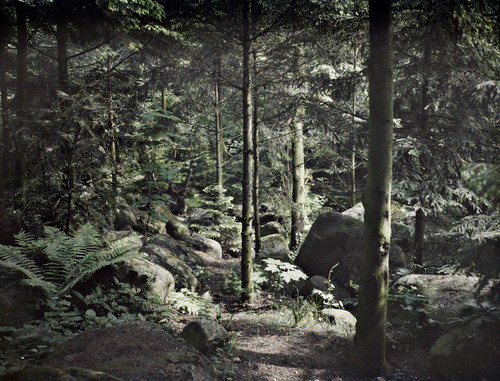
The forêt vosgienne (the Vosges Forest)
On the new land bought between 1897 and 1918, Albert Kahn created a Vosges Forest. This name evokes the grand landscapes of the mountainous region that nurtured his youth.
Although originally from the northern Vosges region, Albert Kahn represented an area from the southern Vosges Mountains, known as crystalline rocks, where granite blocks polished by time sometimes form rocky screes. In order to suggest the high peaks of the Vosges round-topped mountains, embankments were built in order to elevate this portion of the garden. Many conifers as well as deciduous trees were then planted. At the time, rocks and trees, already quite large, transported from the Vosges in wagons, required the neighborhood’s electrical wires to be taken down for their installation!
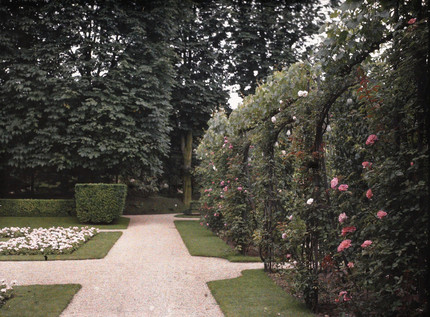
The jardin français and the verger-roseraie (the French-style garden and Orchard & Rose garden)
In 1895, the Duchêne father and son landscaping team designed, according to the style at the time, a “French” garden. Contrary to tradition, this was located at the foot of a majestic greenhouse instead of being aligned with the owner’s residence. This space uses the geometrical vocabulary of classical 17th century gardens and is surrounded by two rows of trees pruned into polyhedron shapes as well as a line of fruit trees opening onto the orchard-rose garden. At the center, a green lawn is still framed by four monochrome flowerbeds, although during Albert Kahn’s time, it was sometimes decorated with parterre gardens. The winter garden, which housed exotic vegetation, also included, before 1914, two adjacent greenhouses with ogee roofs. An orchard-rose garden was created as an extension to this space. Divided by partitions made out of espalier-trained trees, it houses a number of fruit trees, sculpted and symmetrically arranged, while rose-covered arches form a floral tunnel.

The jardin anglais (the English-style Garden)
The English-style garden, landscaped on a parcel acquired in 1895, also seems to be the work of the Duchênes, but that hypothesis has still not been confirmed. Abundant vegetation here organizes the space on gently modeled ground. The cottage is decorated with a sculpted fountain depicting La Fontaine’s fable: the Fox and the Grapes. An artificial riprap evoking a cliff overlooks the sinuous river that widens into a pond; in order to accentuate its rustic aspect, cement balustrades were made to look like tree branches. The wells indicate the location of a dairy that no longer exists today. An aviary housing doves and pigeons completed this picturesque décor.

The forêt bleue and the marais (the Blue Forest and the Marshland)
The blue forest owes its name to the color of the main varieties used: Atlas cedars and Colorado spruces form a delicate bluish envelope that houses, within a clearing, the marsh. These spaces convey the spontaneity of natural landscapes: whether from the Atlas Mountains in North Africa or wetlands with their aquatic species. At the base of the largest trees, an entire range of vegetation has grown, which transforms the space over the course of the seasons. It is also within this ever-changing vegetal universe that Dr. Comandon pursued, in the laboratory, his micro-cinematographic research on the growth of flowers or fauna from the ponds…

The forêt dorée and the prairie (the Golden Forest & the Meadow)
Albert Kahn imagined, with the help of his gardeners, a meadow hidden by a narrow golden forest. Slightly higher than the blue forest, a new colorful veil is revealed: in the spring, the young spruce saplings take on a luminous straw yellow hue; while in autumn, this is relayed by the maple trees’ shimmering golden leaves. These two seasonal events thus give the golden forest its name. Behind this curtain, another surprising spectacle unfolds: a meadow with abundant wildflowers. Annuals and perennials grow freely, creating an infinite number of multicolor paintings, which replace one another as the seasons change. Between the blue “selection” forest and the “Vosges” forest, this clearing represents a delicate transition.
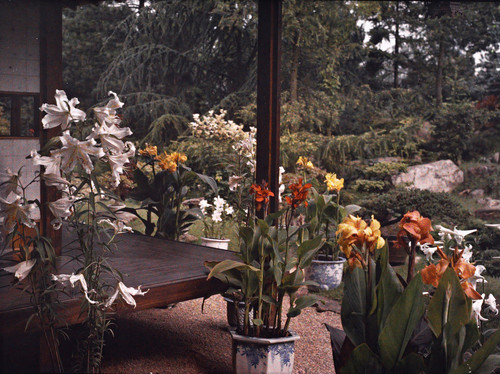
The jardin japonais (the Japanese Village & the Sanctuary)
The Japanese garden, composed with a village (1897) and a sanctuary (1908-1909) was created after Albert Kahn’s travels to Japan. Taking up the largest amount of space in the garden, it recreates, in miniature, the landscapes of Japan where domestic architecture is combined with Asian vegetation and reconstructed sacred sites. The first part of the garden, created in 1897, is the Japanese village, which was the work of Japanese carpenters who came especially from Japan and lived in Boulogne. Access is through the English garden via a double-door wooden portico. On the other side of the village, a more rustic portico opened on to the sanctuary. A five-story wooden pagoda, inspired by Buddhist pagodas in Japan, opened on to the garden, but was lost to a fire in 1953. Abutting this tower, two Japanese wood and rice paper houses, made it possible to exhibit flowers in Japanese pottery or hold small receptions, like tea ceremonies.
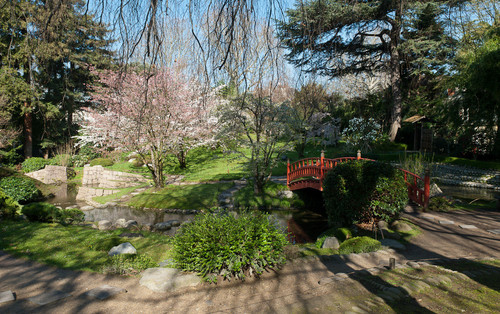
The contemporary Japanese garden
The sanctuary, built between 1908 and 1909 no longer exists today. It was meant to represent sacred sites in Japan and was accessed via two Torii (Shinto sanctuary portico). The red lacquered bridge, replicating the famous Nikko bridge on a smaller scale – which Kahn visited in 1908 – was paired with a rare Sorinto (arrow-shaped pagoda) inspired by the Rinno-ji temple in Nikko and a miniature version of the façade from the famous Kiyomizu dera temple in Kyoto.
Quite damaged, this part of the garden was turned into a contemporary Japanese garden, homage to the life and work of Albert Kahn, created in the 1990s by the landscape artist Fumiaki Takano (1943-2021).
